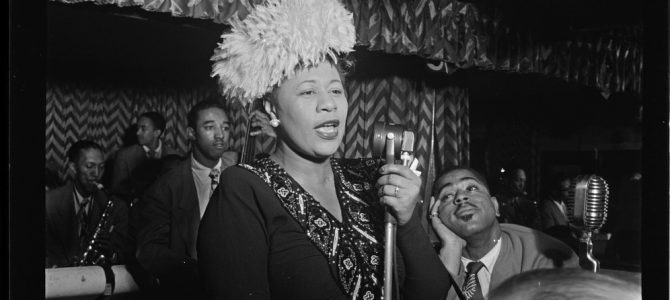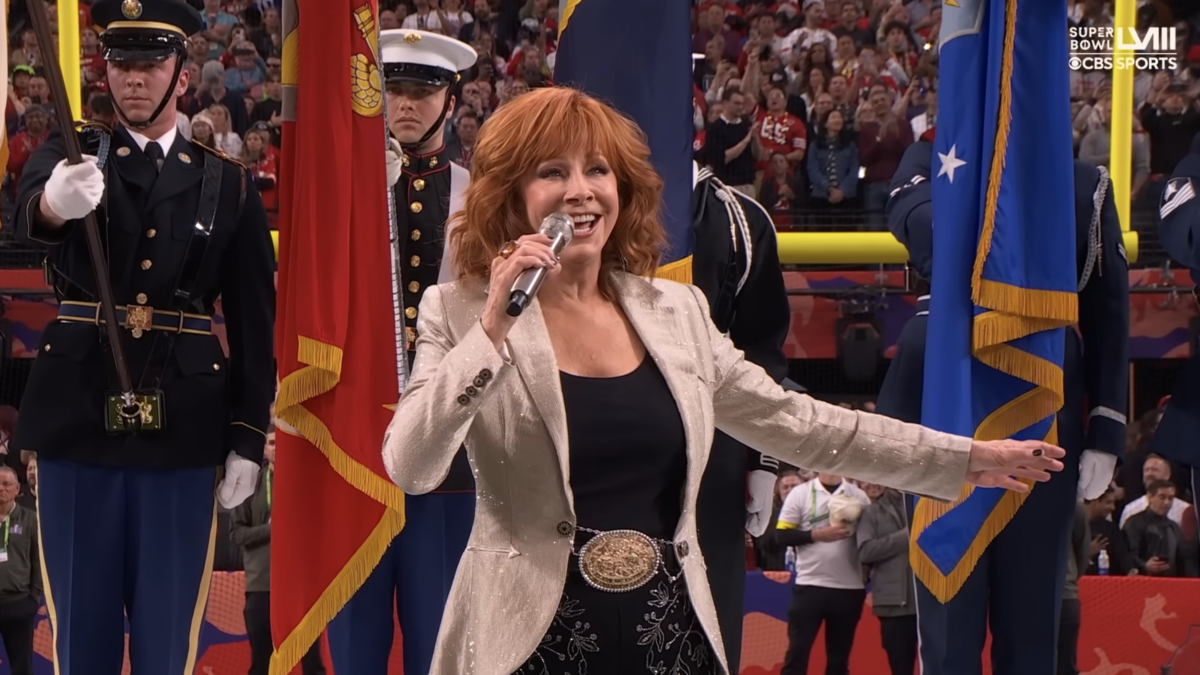
As The New York Times rages against Asian Salad (to be fair, the French dressing sounds inauthentic), we can measure the cultural appropriation crowd’s looniness by remembering the greatest cultural appropriator of them all: Ella Fitzgerald. Amid the Fitzgerald centennial celebrations, including a current exhibition at the Smithsonian’s National Museum of American History, few commentators note that she revived her career by consciously “whitening” her vocal style in her nine Songbook albums.
Starting in 1956, she laid down the canon for the great (and mostly white) popular song composers and lyricists of the previous generation. Ella and her contemporaries would have been shocked that a new twenty-first-century blood-and-soil elite would try to dictate who could sing (and wear and eat) what. As the civil rights movement gathered force, that’s what she was musically trying to destroy. Cultural appropriation is the essence of American music and American culture.
Let’s Slide Through Ella Fitzgerald’s Musical Development
Fitzgerald started recording with the Chick Webb band in 1935, in her late teens. The band was mostly based at Harlem’s Savoy Ballroom, and the recordings reveal a singer with a Southern black accent. (Fitzgerald’s mother, Temperance, had joined the Great Migration, moving from Virginia to Yonkers soon after Fitzgerald’s birth.) She often uses a broad tone with affinities to those of blues singers, as in “Mr. Paganini (If You Can’t Sing It, You’ll have to Swing It).”
She sang lots of novelties, sometimes with double entendres about drugs (“Wacky Dust”) or sex (“The Muffin Man”) that made black and white fans feel authentic and in-the-know. Despite the girlish innocence of her nursery rhyme hit, “A-Tisket, A-Tasket,” for example, that lost “brown and yellow basket” may not have referred to wicker. As a child, the destitute Fitzgerald had worked as a lookout at a brothel.
Fitzgerald’s purity of tone, harmonic approach, and acrobatic vocal style were modelled on the white New Orleans singer Connee Boswell—herself influenced by black singers. Like other swing-era musicians, Fitzgerald also mixed genres. See “Bei Mir Bist Du Schoen” during the late 1930s vogue for Yiddish songs, and the “Cow Cow Boogie” about a singing cowboy “raised on locoweed” who had “a knockout Western accent with a Harlem touch.”
With Webb’s death in 1939, Fitzgerald began fronting his band. As the war years approached, popular music took on a lusher, more sentimental tone. Trumpeter Harry James’ band had the era’s signature sound. Fitzgerald, in turn, cultivated a more straightforward style and reduced her accent. By the mid-1940s, she would meet even Harry Reid’s demanding Obama test: “a ‘light-skinned’ African American ‘with no Negro dialect, unless [s]he wanted to have one’”—and she didn’t want to have one.
Straddling the Divide Between Sweet and Hot
Fitzgerald was breaching the divide between “sweet” music, which was supposedly purely white European-style, sung right over the melody and supported by lush harmonies, and “hot” music, which was supposedly purely African-American, with syncopated rhythms and improvised vocal and instrumental lines. She was joined as a cultural appropriator by Nat “King” Cole, who also lost his African-American accent as he transitioned from pianist to vocalist in the late 1940s, emulating Bing Crosby’s smooth style.
While some white bands were exclusively sweet (Guy Lombardo) and many black bands primarily hot, boundaries were always permeable. As far back as the 1910s, African-American bandleader James Reese Europe was musical director for the sensational white dance team of Vernon and Irene Castle, while Jewish singer Sophie Tucker growled raunchy (and influential) blues.
In the 1920s, the leading African-American female vocalist, Ethel Waters, switched between sweet phrasing in standard diction (including rolled r’s), and hot vocals with an African-American accent. In “Don’t Blame Me,” she used both in the same song. Fred Astaire and Ginger Rogers’ first dance duet, the Brazilian-themed Carioca in “Flying Down to Rio” (1933), is backed by a “sweet” arrangement. After an African-American vocalist’s interlude, the pair then perform a “hot” duet.
The Times Change, and So Did the Music
As the big band era faded during the World War II draft, Fitzgerald became a solo act, engaging in her next act of cultural appropriation. Bebop’s originators were primarily African-American, but their harmonic structure drew from early twentieth century European chromaticism, and their even strings of eighth notes were influenced by Bach. Ella embraced the new music, scatting through a reworked version of the 1920s Gershwin tune “Oh Lady Be Good” (and recycling it for decades), to the point where she later claimed that by the 1950s, she couldn’t find work because she was only singing bebop.
Fitzgerald exaggerated: throughout her 260-side run for Decca from 1935-1955, this busy professional worked in a range of ballad, swing, and Broadway idioms (though rarely the blues). After the Caribbean migration to the Northeast, and well before Harry Belafonte’s arrival, she culturally appropriated calypso in “Stone Cold Dead in the Market,” picking up a dead-on accent in her then-home of Queens.
But Ella faced a crossroads by the mid-1950s, as her Decca contract ended. Bebop had never been a huge commercial success, and big band swing was far in the past. Fitzgerald, pushing 40, had little appeal for young rhythm and blues or rock ‘n roll audiences. After producing a career retrospective Songbook record series for Fred Astaire in 1952, her manager, Norman Granz, envisioned Fitzgerald’s boldest act of cultural appropriation. He would produce a canonical Great American Songbook from the work of the major American pop composers from 1925-1945. She would employ her pure, girlish tone to sing them in a straightforward, uninflected, on-the-beat style, often at excruciatingly slow tempos, over plush Populuxe swing arrangements.
To take one example from the vast series, Cole Porter’s ballad of prostitution, “Love for Sale,” sounds like it was done under the influence of Fentanyl rather than Wacky Dust. Most “sweet” singers of the 1930s had never done anything this radical, although Bing Crosby, distancing from his early cultural appropriation of Louis Armstrong, came close. Granz repositioned Fitzgerald as the black Kate Smith, girlish, sexless, and overweight (the singer struggled with diabetes in later life), and a tribune for listeners horrified by slender, sexual, harmonically primitive rock ‘n rollers.
Without Cultural Appropriation, There’d Be No Ella Fitzgerald
Discussing Fitzgerald’s musical strategy, Benny Carter, who had discovered her at the Apollo Theater in 1934, told me, “And it worked!” Fitzgerald developed a new audience for her LPs and appearances in concert halls and on TV variety shows. Ella continued to reprise old hits and licks from all the way back to Chick Webb days. On hearing Fitzgerald in concert, one singer friend was horrified to discover how little was improvised.
Even in a successful series of jazz albums with Louis Armstrong, Fitzgerald struggled to navigate her identities. For years, I thought her performance on their Porgy and Bess album was clueless. In fact, she gamely deployed her “white” style to somehow depict a stereotypical, oversexed black George Gershwin/DuBose Heyward character, while simultaneously supporting Armstrong’s highly improvised “black” vocal line. It’s amazing she didn’t get whiplash.
Ella was guarded about her personal life, which helped burnish her black Kate Smith image, but she was no innocent girl. Long after her death, a glimpse of the real person appeared in “Twelve Nights in Hollywood” (2009), the excellent, unexpurgated version of a 1961 album. “Bewitched, Bothered and Bewildered” is the work of a woman who’s been around the block—Fitzgerald had been divorced twice by then, with reports of a secret third marriage—unlike the bland Songbook version. In this live album, recorded in front of an entertainment industry audience at the Crescendo club, the singer is sardonic, chatty with friends, annoyed at people talking over the music, and recklessly (and cheerfully) improvisatory.
With rock’s triumph in the 1960s, Fitzgerald’s days as a huge pop star came to a close, but she continued to work regularly in large halls like Radio City, where I heard her around 1987. Jazz fans formed a larger segment of her remaining fanbase. She employed a more improvisatory style, particularly in her late-career albums with guitarist Joe Pass, and selectively reincorporated a “black,” bluesy, rougher sound into her singing.
Cultural appropriation was no taboo for Ella Fitzgerald—she built her career on it. If the social justice warriors want to police it, they’ll need Hillary’s digital goons to BleachBit every Ella Fitzgerald .mp4—not to mention the rest of American music—off the face of the earth.









